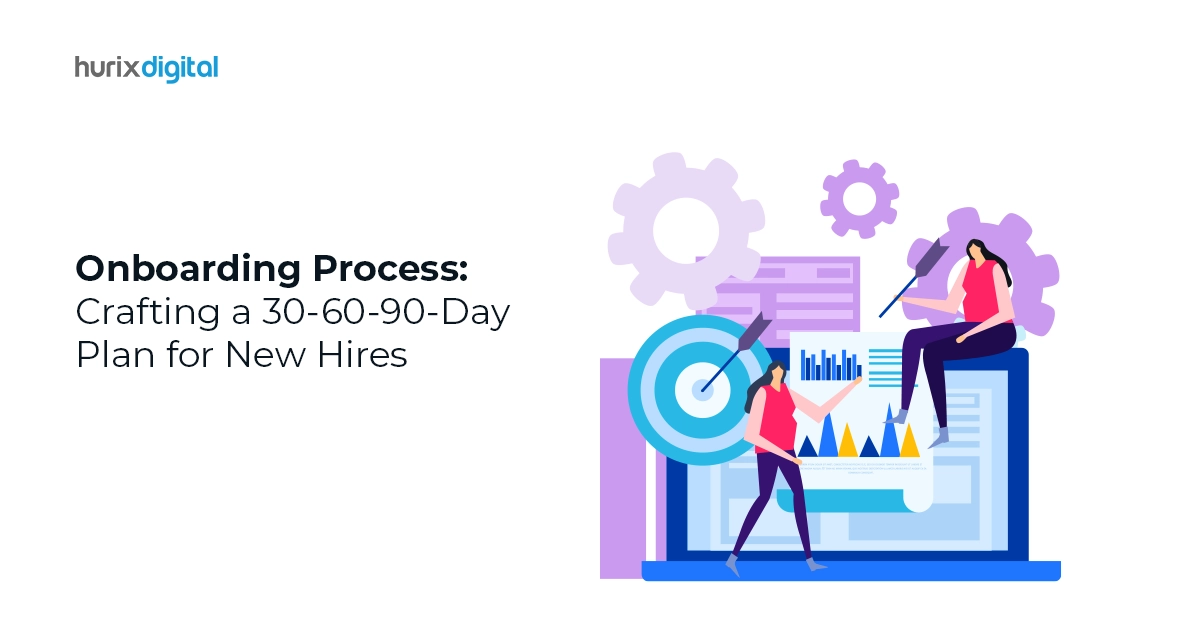
Onboarding Process: Crafting a 30-60-90-Day Plan for New Hires
Summary
Discover how to design an effective onboarding process with a detailed 30-60-90 day plan. This article offers strategies for integrating new hires and setting them up for success.
Taking on a new job brings a mixed bag of emotions. While there is excitement, transitioning to a new role can intimidate even an experienced employee. With so much to unlearn and learn, adapting to the new work culture can be stressful for new hires.
A poor onboarding process can add to the challenges. In fact, 52% of employees say that without proper onboarding, they feel untrained. Thankfully, having a clear employee orientation plan in place solves this problem.
Join us as we explore onboarding best practices through the 30-60-90 day plan in this post. Let’s start!
Table of Contents:
- What Does the 30-60-90-Day Onboarding Process Refer To?
- The Importance of Employing the 30-60-90 Employee Orientation Plan
- How to Design a Well-Thought 30-60-90-Day Plan?
- Wrapping up
What Does the 30-60-90 Day Onboarding Process Refer To?
Onboarding doesn’t mean signing new hires’ paperwork and then taking them to their workstation without any communication. This will not only make them feel disoriented about their role but also undervalued. As a result, most employees leave the job within the first 44 days.
That’s where a 30-60-90 day onboarding process plays a crucial role.
The 30-60-90-day framework gives a clear line of action for a 90-day onboarding process divided into a 30-day timeline.
By setting realistic goals for the new hire’s role at each phase of the plan, you can make the onboarding process smooth. This plan outlines feasible milestones, helping the new hires understand their responsibilities and assimilate with the company’s policy.
Here’s a quick overview of how a 30-60-90 day plan works:
- 0–30 Days: This stage is about unlearning and learning, so it is pretty training-intensive. Introduce the new hires to the company’s tools. Also, share project nuances and set small, achievable goals for new hires.
- Day 31–60: At this point, focus on role-specific tasks while reducing the training part. Start assigning employees more responsibilities to improve collaboration across the team.
- Day 61-90: Allow the employees to take on more responsibilities and add value to their roles. At this stage, you can hold them accountable for the assigned task. Also, new hires should be encouraged to complete projects with limited guidance from superiors.
Also Read: Ensuring Consistency and Quality in Translated Workforce Learning Materials
The Importance of Employing the 30-60-90 Employee Orientation Plan
The 30-60-90-day plan is a comprehensive framework with endless benefits. It not only makes the transition seamless for new hires but also helps HR/managers create a clear onboarding process.
Following are some of the major reasons for having a concise new hire onboarding plan:
1. It Helps You Set a Clear Course of Action
Starting a new job comes with several challenges. There’s always something going on that can disorient employees about their roles and responsibilities.
Handing new hires an onboarding checklist can set a clear course of action. How, you will ask? A dedicated employee orientation plan provides new hires with a coherent outline of their role and responsibilities.
Also, the 30-60-90 day plan gives a summary of monthly goals and how to achieve them. As a result, new hires gain a better perspective and understanding of the job from day one.
2. Boosts Productivity
The 30- to 60-day onboarding process ensures that new hires are on the same page as the rest of the team. By having a concise onboarding checklist, uncertainty and indecisiveness can be avoided.
Putting an employee orientation plan in place provides a roadmap and guidance to achieve goals within the first three months.
In addition, a 30-60-90-day plan allows you to track employees’ progress and provide support when required. You can also identify skill gaps to create an appropriate training plan for new employees to meet the goals.
3. Clearly Communicates Priorities
By coherently setting and articulating those priorities, new hires know what needs to be done, how, and when. The 30-60-90 day onboarding process provides a precise agenda consisting of timelines and goal priorities.
Moreover, this employee orientation plan encourages better collaboration between managers and new hires. The team leads, and managers can provide feedback, allowing employees to identify their strengths and work on their weaknesses.
4. Enhances Employee Engagement
A report states that around 46% of new hires felt more engaged with companies with a smooth onboarding plan. This shows the significant impact that a well-structured onboarding process can have on employee engagement.
Employee engagement strategies such as game-based learning within a 30-60-90 day plan create a conducive work culture.
A positive working environment not only improves job satisfaction but also encourages a sense of commitment among new hires towards your company.
5. Increases Innovation and Creativity
In today’s jet-paced business world, innovation is the key. It’s crucial to nurture a culture of innovation and creativity among the new hires. Assigning tasks focusing on critical thinking and problem solving within a 30-60-90 day plan acts as food for (innovative) ideas.
This not only results in new hires’ professional growth but also allows them to develop a new perspective on problem-solving.
How to Design a Well-Thought 30-60-90-Day Plan?
Here’s how you can design a well-thought-out 30-60-90-day plan for new hires:
1. Build a Roadmap for New Hire Onboarding
Before crafting an employee orientation plan, ensure the new hires can easily fit into your company’s mission and vision. To build a roadmap, start by brainstorming questions like:
- What are the expectations of a new hire for a particular role?
- Do you want to hire new employees to solve a specific problem?
- What are the roles and responsibilities of a new hire?
These questions will create a better plan for new hires to acclimate to the company culture and build the necessary skills for the role.
2. Look at the Bigger Picture
The ultimate purpose of a 30-60-90 day plan is to help new hires align with the company’s business objectives. So, make sure you look at the big picture. For example, the metrics should focus on actual output rather than training.
3. Set Smart and Flexible Goals
Goal setting is the key to a successful 30-60-90 day onboarding process. Easy goals will take productivity down.
The secret is to set SMART and stretch goals that are challenging, realistic, and achievable. Progressive goals not only make new hires more productive but also allow them to develop a strong skill set, which can be beneficial in the long term.
4. Review the Milestones Regularly
What new hires accomplish during the first 90 days lays the foundation for their success in the organization. However, it’s important to keep the plan flexible. The new hires may have to work on tasks not mentioned in the plan.
Therefore, review milestones regularly in the first few weeks. This will allow you to iterate the plan to accommodate additional assignments and track the progress accordingly.
Also Read: Top 5 Trends in Workforce Learning and Development
Wrapping Up
In a dynamic work environment, talent retention plays a crucial role. To ensure new hires feel welcome and appreciated, an effective onboarding process is the key.
Crafting a 30-60-90 day plan helps you create a strong and positive first impression of the company. This also ensures that new hires are equipped with the necessary knowledge, skills, and resources to excel in their roles.
While the internet has several templates, partnering with experts like Hurix Digital ensures you get a comprehensive employee orientation plan. We have over two decades of extensive experience and offer scalable solutions for a streamlined onboarding process.
Contact us today for more details!

A highly enthusiastic and motivated sales professional with over twenty five years of experience in solution selling of training-related applications and services. Maintains an assertive and dynamic style that generates results. Ability to establish long-term relationships with clients built on trust, quality of service and strategic vision. Specializes in financial services, higher ed, publishing and government in the areas of learning and development.



